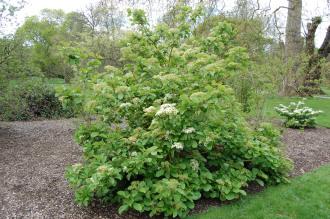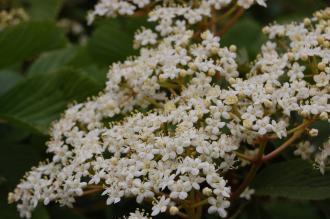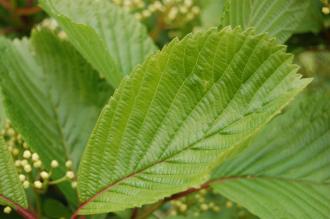
Viburnum sieboldii (19/04/2014, Kew Gardens, London)
Position: Full sun to partial shade
Flowering period: Late spring
Soil: Moist, well drained
Eventual Height: 7m
Eventual Spread: 5m
Hardiness: 4a, 4b, 5a, 5b, 6a, 6b, 7a, 7b, 8a, 8b
Family: Adoxaceae
Viburnum sieboldii is a deciduous large shrub or small tree with an open habit. Its dark green leaves are elliptic with serrate margins, up to 10cm long and 6cm broad. Its leaves have a distinctive fragrance when crushed. Its white hermaphrodite flowers appear as flattened corymbs which are up to 15cm across. Its fruit are oval drupes, initially red maturing to black, are up to 12mm long and appear in clusters in autumn.

Viburnum sieboldii Flower (19/04/2014, Kew Gardens, London)
Viburnum sieboldii, commonly known as Siebold Viburnum or Siebold’s Arrowwood, is native to Japan. In its native habitat it grows in thickets.
The etymological root of the binomial name Viburnum is from the old Latin name for the Wayfaring tree. Sieboldii is named after Phillip Franz von Siebold (1796-1866), German physician and naturalist.
The landscape architect may find Viburnum sieboldii useful as a large shrub with attractive flowers and berries which are attractive to wildlife.

Viburnum sieboldii Leaf (19/04/2014, Kew Gardens, London)
Ecologically, Viburnum sieboldii flowers are attractive to pollinating insects. Its berries are attractive to some birds.
Viburnum sieboldii prefers moist, fertile, well-drained soils. It tolerates most pH of soil.
Viburnum sieboldii requires little maintenance. Any necessary or formative pruning should be carried during the winter months.

